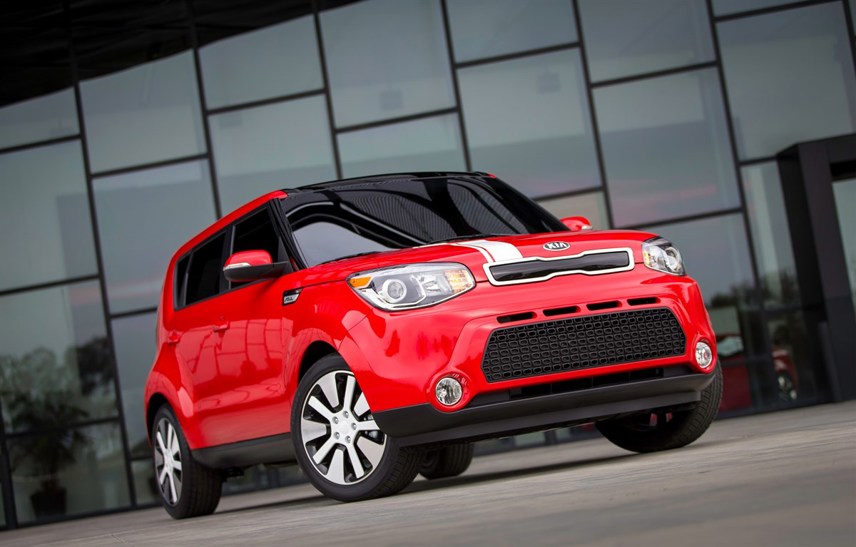Review
The first generation Kia Soul marked a step change for the brand in the UK. It had already introduced its Ceed which has gone on to be a core staple of the Korean brand’s range, but the Soul marked it out as being able to offer something funky, different and more design focussed.
Those brand values can be seen throughout the range now and the next-generation Soul has taken those ideas and pushed them on. The exterior is even chunkier than before and there are optional colour combinations available to customers on the top trims that give the Soul a black roof contrasting with the body colour, much like a Mini or Range Rover Evoque.
B-segment SUV sales account for over 95,000 units in the UK alone and this is expected to rise to 150,000 by 2015, so it’s clear why so many manufacturers are looking to introduce models into this segment. Kia is seeking to sell 3,000 units of the new Soul in the UK in a full year of sales, just a 3.2% share of the potential market. Retail is the focus with the new Soul, although there a little user chooser interest with around 30% of sales going to fleets.
Kia admits the average age of the previous generation Soul was high due to its popularity with Motability sales.
The best-selling version is expected to be the Connect Plus 1.6 CRDi Manual (tested here) with around 20% of sales. That trim level (all engine and transmission variants) is expected to account for 35% of all sales.
The new Soul is roomier than the outgoing model, with an increased length of 20mm, it is 15mm wider and 10mm lower. The cabin is more spacious and visibility has been improved with thinner A-pillars.
The change in dimensions means the Soul has a slightly more aggressive stance on the road, but it also means more space in the boot which has been increased to 354-litres. This compares favourably with rival model the Nissan Juke which has 251-litres of space in the boot, while the Renault Captur is actually the most practical option in terms of boot space with 377 litres on offer.
The biggest changes on the new Soul can be found in the interior. There are now soft touch dash plastics and more of a premiumfeel to the trim finishes in the cabin.
Three trim levels are available now; Start, Connect and Connect Plus and range topping Mixx and Maxx will join the range in July.
New standard features on every Soul include DAB radio, Flex Steer variable power-assisted steering and a tyre pressure monitoring system (TPMS). Also fitted to every model are painted bumpers, door handles and side mirror casings, keyless entry, air conditioning, electrically adjustable door mirrors, electric windows all round, steering wheel-mounted controls, USB and AUX ports and six airbags.
All versions are front-wheel-drive five-door crossovers - Kia research has shown that while buyers desire the appearance, semi-elevated driving position and perceived safety advantages of a 4x4, they do not want the higher fuel consumption and taxation that four-wheel drive entails. There are two engine options with a 1.6-litre diesel and a 1.6-litre petrol.
The improvements in the cabin continue behind the wheel too, with tight and precise gear changes on offer. The steering on the Soul is quite light, perfect for city driving and the new model feels more composed and solid than the previous version. Customers can change the steering weight with Kia’s Flex Steer system to adjust it to their liking. The ride also feels improved, with the previous model feeling crashy on large alloys, while the new model is much better at absorbing bumps.
The diesel version of the new Soul was the only model available to drive at the launch, but it was a capable unit offering plenty of power and torque. The problem Kia has is that it’s not competitive on CO2 against rivals like the Captur which is 95g/km CO2 with its entry level diesel or the Juke at 104gkm. The Soul offers 132g/km of CO2 and 54.5mpg which will hurt its prospects as a fleet option or for retail buyers increasingly making purchase decisions based on running costs.
Kia will introduce a fully-electric version of the Soul towards the end of the year, but this still won’t be a mainstream fleet option.
Kia has pushed its Soul even further towards the mainstream with a much improved interior, ride and funky design which stands out against its competitors. However, the Soul plays a small part in Kia’s now established core model range and it will have to shout loudly to be heard above models which lead Kia’s marketing like the Sportage.
Author:
Fleet News
Specs
| Manufacturer | Kia |
| Model | Soul |
| Specification | |
| Model Year | 0.00 |
| Annual VED (Road tax) | £0 |
| BIK List Price | £16,215 |
| CO2 | 132g/km |
| BIK Percentage | 22% |
| Insurance Group | N/A |
| CC | N/A |
| Fuel Type | Diesel |
| Vehicle Type | |
| Luggage capacity (Seats up) | N/A |
Running Costs
| P11D | £16,215 |
| Cost per mile | 32.71ppm |
| Residual value | £5,225 |
| Insurance group | N/A |
| Fuel Type | Diesel |
| Cost per mile | 0.00ppm |
| Fuel | 0.00ppm |
| Depreciation | 0.00ppm |
| Service maintenance and repair | 0.00ppm |
Info at a glance
-
P11D Price
£16,215
-
MPG
56.5 -
CO2 Emissions
132g/km -
BIK %
22% -
Running cost
3 Year 60k : £5,225 4 Year 80k : £4,100 -
Fuel Type
Diesel
















Login to comment
Comments
No comments have been made yet.